
![]()

|
|
|
|
Flags, Banners, and Miscellaneous Cloth
Page 3
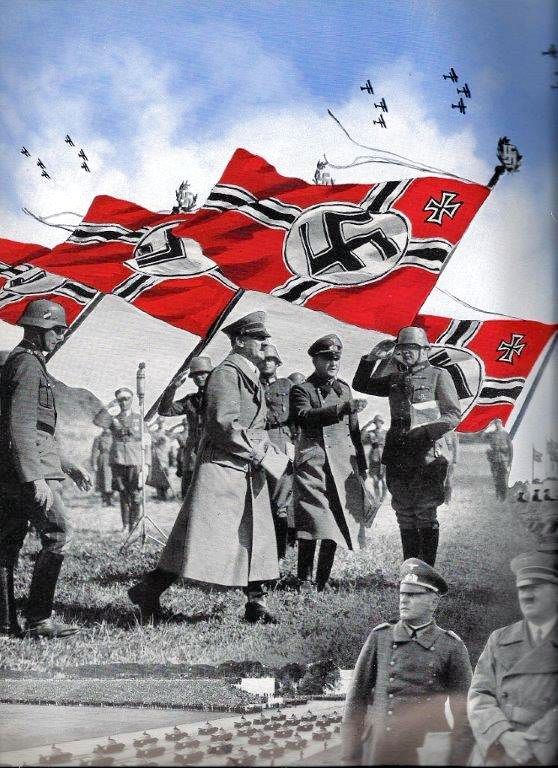
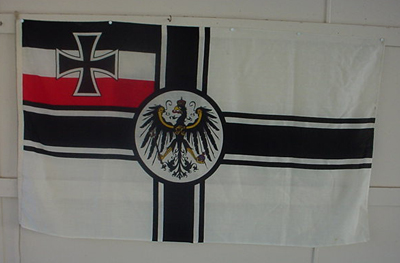 |
Imperial Battle Flag (Item FLAG 3-1 & KCLOTH 2-7 & WWI 12-6) |
DESCRIPTION: Here is a specimen in nearly mint condition of the Kaiserreich battle flag. We are not sure if it was manufactured in the period leading to or during the First World War. It could have been produced in the 1930's or 1940's. The Veterans Associations used this ensign in all their parades and ceremonies. The condition is great and it has the label of the flag maker on its rope edge. It is a great size for the collector (53" x 31") and is a very dramatic looking flag. It has the rope running through the left side (stitched on) with the loop and tie lanyard all there. The Banner Fahne Fabrik was known to make the finest in flags and standards in the Imperial era and in the Third Reich (they made the best!) PRICE: SOLD |
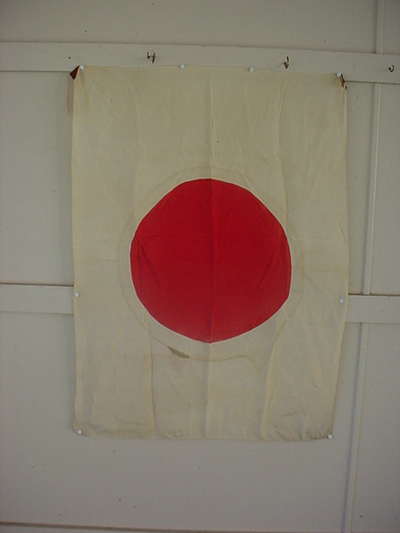 |
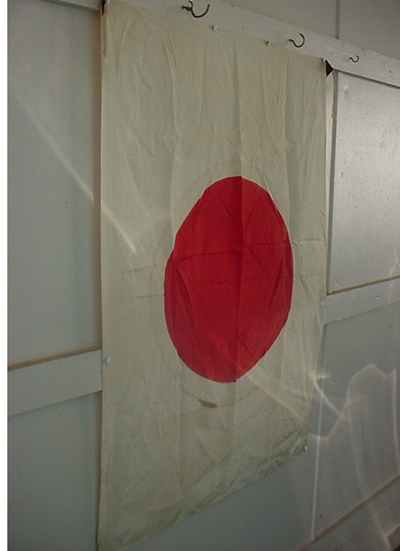 |
Japanese WWII Flag (Item FLAG 3-2) |
DESCRIPTION: This is the traditional battle flag of the Japanese WWII forces that was to them known as the personal battle flag. Know to the American army soldiers opposing them as the "Meatball." The Japanese soldiers carried one with each soldier for nationalistic and ideas based on religion and the Order of Bushido (the way of the warrior). The flag measures about 25 x 45 inches and has leather tabs at the hanging end. It bears stains and one rip under the risin sun center, but it is still a very good war souvenir of the Pacific War. PRICE: SOLD |
 |
 |
 |
20. 20. Juli 1939: Hermann Göring vor der Hauptverwaltung der Hibernia AG in Herne Hermann Goring in front of the headquarters of the Hibernia Herne AG: July 1939 |
| Zechenzeitung: Hermann Göring besichtigt das Hydrierwerk Scholven "Hermann Göring ist da! ... Jedenfalls stand am 20. Juli 1939 morgens gegen 11.30 Uhr Hermann Göring unerwartet vor unserer Hauptverwaltung. Er hatte gelegentlich bei seiner Fahrt über die Wasserstraßen Deutschlands im Rhein Herne Kanal mit seiner Jacht "Karin II" Station gemacht. Es ist verständlich, dass der Besuch des Generalfeldmarschalls wie ein Alarm durch die ganze Verwaltung lief und einige hundert Menschen wie einen Bienenschwarm durcheinander brachte. ... Von Herne aus ging dann, einem Wunsch des Generalfeldmarschalls entsprechend, die Fahrt weiter zum Hydrierwerk Scholven. Hermann Göring besichtigte mit großem Interesse dieses im Rahmen seines Vierjahresplanes neu entstandene Werk und äußerte seine lebhafte Befriedigung über den hohen Stand der Produktionsentwicklung..." Mine newspaper: Hermann Goering visited the hydrogenation Scholven |
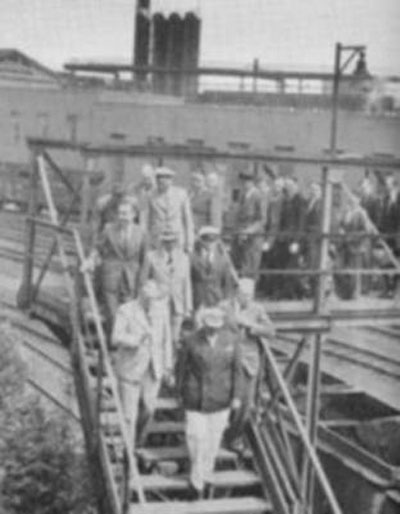 |
 |
Image: Gelsenkirchen stories. Scholven 1936, erste Lieferung synthetischen Benzins aus Steinkohle Scholven 1936, first delivery of synthetic gasoline from coal |
| Bild: Hibernia Zeitung, Poster 1937 Das Poster in DIN A4-Format aus der Zechenzeitung der Hibernia zeigt ein Jagdflugzeug der deutschen Wehrmacht. Im Bildrand unten links befindet sich das Wappen der Hibernia, welches zur Zeit des Nationalsozialismus unterhalb des Hibernia-Schriftzugs das durch ein vierblättriges Kleeblatt ergänzte Symbol Schlägel und Eisen zeigt und oberhalb den preußischen Reichsadler mit einem Hakenkreuz auf der Brust, in der rechten Kralle ein Schwert haltend, mit der linken Blitze schleudernd. Image: Hibernia newspaper, poster 1937 |
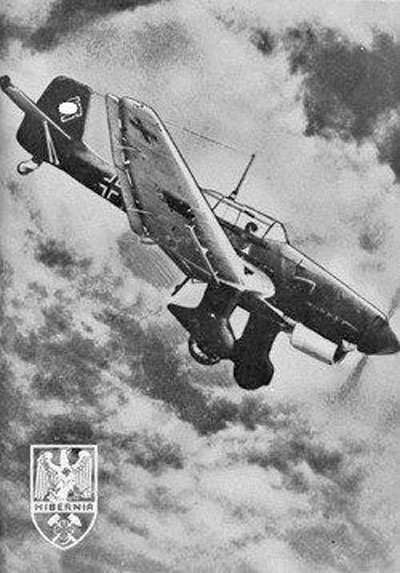 |
Wonderful Bugle Banner of the Hibernia Zeche Kameradschaft (Item FLAG 3-3) |
DESCRIPTION: Here is possibly the most beautiful, most rare, most interesting item of vast historical interest that we have ever handled. This banner is from a brass band that was formed in the area of Scholven. Here was found the vast and massive plan for the conversion of coal into gasoline. Had it succeeded and somehow escaped the night and day bombing runs made by the enemy (England and America), the outcome of the war might have been far different! The hydrogenation Scholven was purely a military operation. The fuel supply was meant exclusively for military purposes, however, as early as 1933 Hitler had announced in February that under his four year recovery plan public measures would serve to create jobs and the militarization would make Germany ready for war because he knew that Britain and France were looking menacingly at Germany to say nothing of the great danger that loomed in the Communist East. So with the placement of this four year plan to have Germany's people working again and to supplant an awareness in the people for the possibility of war, Hermann Goring is appointed as the Tsar of the great social and military venture. Gorings’ task in the context of this plan was to align the companies of the Reich and if necessary there would be government intervention in all production process within the agenda of the National Socialist economic policy in peace or war. Germany wanted to also be self-sufficient, completely independent of foreign supplies of raw materials. A most difficult task when one considers that at that time potash, lignite and coal were in insufficient quantity and crude oil was scarce so this led to the construction of hydrogenation Scholven in 1935 and the mining company Recklinghausen and mining company, Hibernia, are now subsidized and nationalized. For traditional reasons, the Hibernia Company keeps the name Hibernia A.G. (more lately). The goal of the four year plan is to use 10% of the coal for the experimentation in the methods of converting coal to petrol (gas). In July 1936., for the first time the Hibernia AG Co. has success in the production of gasoline from coal tar, three weeks later directly from coal. Hibernia decided after this pioneering achievement to actually make the first hydrogen production plant for the process. They are no longer just a mine they are now a full- fledged plant producing synthetic gasoline from coal. In 1938 the ministry of hydrogenation Hermann Goring instructs the plant to switch the production of 200,000 tons of gasoline for autos and trucks to 180,000 tons of jet fuel. So important was the Hibernia plant that at this point an entire huge community of workers with government supplied housing was established and social events were planned and acted upon by happy workers. The symbol or logo of Hibernia was the Prussian eagle holding in his right claw a sword and in his left, lightning flashes. In the center of his chest is seen the swastika of the Reich and under the eagle is a black scroll with the name Hibernia! -- under this you will see a four leaf clover or shamrock, placed upon the crossed hammer and chisel that has been the traditional logo of German miners for centuries. The mining community had its own local newspaper and in 1937 a poster that hung in plant work places, offices and workers mess halls showed a JU-88 Stuka dive bomber that has this Hibernia symbol shown on it. Reichsmarshall Goring made quite a few official visits to all the hydrogenation plants and especially Hibernia. He expressed his lively satisfaction at the high level of production development that had been reached there. Wherever Goring went, extremely jubilant people gathered to greet him while chanting Unser Hermann -- Our Hermann. Hibernia and the other mining communities in the Scholven Gelsenkirchen area were as patriotic National Socialists as could be found in the Reich. In 1932 nearly 40,000 people were out of work in the economic crisis, in 1939 the employment offices of the city reported only 100 people unemployed. The industrial companies complained of a labor shortage; the people had good cause to be thankful to the National Socialist Party and especially the four year plan manager Goring. Every National Socialist event in the N.S. calendar was ceremoniously honored and celebrated to the absolutely fullest extent. The Fuhrer’s Birthday, the observance of the Putsch in Munich, and the Machtergreifung ascension to power by the National Socialists party. There was a sharply dressed musical band who played the Horst Wessel Leid to symphonic excellence and that is where our bugle banner comes in -- but first let’s look at the first origins of the name Hibernia and its use in N.S. Germany. The name of course is the classical Latin name for the Emerald island of Ireland. But how does it come to be used in Germany? Did you ever hear of the expression “Coal to New Castle”? The Irish who wanted to invest refused to invest in the English coal industry in the 1800’s because to the patriotic Irish, England was the ‘traditional enemy’ so they looked east and since there was always a great predilection between the Irish and the Germans, several Irish entrepreneurs decided to actually sink shafts in the Gelsenkirchen area and there were two other mines besides Hibernia...the Shamrock and the Erin...and by 1800 they were united under the name Hibernia. The first man to actually open those mines was a Victorian Irish gentleman by the name of William T. Mulvany 1801-1885. We mentioned earlier that it was by tradition a word scared to Germans (real Germans) that the Hibernia name was preserved even in the Nationalization of the industry. And this tradition is surely the reason the shamrock was made part of the N.S. banner and probably myriad other objects. The banner is double sided with the eagle and shamrock on one side and the other side has the swastika on white circle with red background. The eagle is absolutely gorgeous with the sword and lightning bolts in silver bullion. All around the side edges and bottom you can see the black fringe. This white field with black is typical as the colors of Prussia and Gelsenkirchen was and is the German state of Prussia. The banner with the fringe is about 20 inches across and 18 inches high; the quality is absolutely remarkable, so here we offer a thing of obvious beauty but because of its connections to an industry that, if it succeeded, could have won the war for Germany. It is of remarkable and of eminent importance. PRICE: $8,500.00; Special reduced offering on the absolute, most-important banner ever offered on the web. Now offered for $4,500.00 (Incredible!!!) |
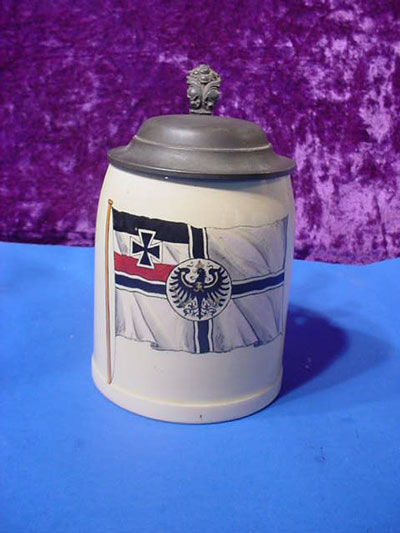 |
Reichskriegsfahne Beer Stein (Item FLAG 3-3 & KSTEIN 2-9) |
|
DESCRIPTION: Here is a small beer stein in crockery material with pewter lid. It has the Imperial war flag as its frontal design. It stands about 5 ½ inches high and is about 4 inches wide great for the short drink of suds always enjoyed by the “Matrosen” (sailors) after a successful naval engagement. These steins were typically used by the Kaiser's Navy personnel .in World War I. All ships of the military fleets used the Reich war flag once they set out to sea .We feature a few actual Kreigsfahne within our pages in the Kaiserreich flag section. The lid is of ‘zinn’ (grey metal) and the thumb lift has floral design, there are no company markings on the body. A very nice little beer stein with Imperial naval connotations. PRICE: SOLD |
|
 |
A Magnificent Little War Flag (Reichskriegsfahne) (Item FLAG 3-4 & VETS 2-11 & KCLOTH 2-5) |
| DESCRIPTION: Seldom do you ever see these little gems available. It measures two feet by 13 inches and it is in perfect condition with no moth holes even though it is more than 80 yrs old or older. It has the reinforced bunting border with the rope attachment. It has no stains at all (unusual). The piece could be from the Imperial Period 1914-1918 or it could be a veteran's piece produced from 1918-1940 or so. It is a flag, not a pennant; the usage of which we are not sure, but this is a real little charmer. PRICE: SOLD |
|
|||||||||||||||||||||
Double-sided Party Banner (Great Condition) (Item FLAG 3-5) |
|||||||||||||||||||||
| DESCRIPTION: Here's the typical banner of the in NSDAP. It measures 95 inches by 46 and is in great condition throughout (clean!). Not too much more we can say except that seldom is one this immaculate, original, and long. It's just about perfect with no mothing, tears, or rips. It is of a fine cotton material.
PRICE: $425.00; just as nice as you have ever seen |
|
|||||||||||||||||||||
Party Banner of the NSDAP (double-sided) (Item FLAG 3-6) |
|||||||||||||||||||||
| DESCRIPTION: Here is nice, clean, original N.S. Party banner size. This banner has a section at its edge, doubled over, but that is not sewn down for the attachment of a pole for display purposes and it would only be used if needed in that manner. It is a particularly nice example and measures 115 x 36 inches.
PRICE: $585.00 |
|
|||||||||||||||||||||||
Another NS Banner (one sided) (Item FLAG 3-7; SA 11-7) |
|||||||||||||||||||||||
| DESCRIPTION: This one is in good shape and has rope and clip attachments for display on a pole or hooks on the wall. It is single-sided, so it is not a true flag. Rather, it was for display at an SA Sturm headquarters. This is the typical size and construction piece used as stated or even on trucks and personnel lorries that were used on early SA missions. The size is 40 x 30 inches. There are a few old stains in the white field, but they really don't detract from what is a nice memento of the Kampfzeit.
PRICE: SOLD |
|
||||||
Huge National Socialist Banner (Item FLAG 3-8) |
||||||
| DESCRIPTION: This is a 182 x 58-inch one-sided banner of the type that would hang from a window sill or behind a speaker at the podium. It’s one sided with the swastika only on the one face side. It has a few minor holes and not-so-prevalent stains; otherwise it’s in really decent shape. It’s an item getting more and more scarce by the day. Grab it “now;” you may not get the opportunity again.
PRICE: SOLD |
|
|||||||||||||
|
|||||||||||||
| DESCRIPTION: This is the style of flag that would hang upon flag staffs of post offices, universities, police stations, and government buildings of all types. For some reason they are much more scarce than the Reichs Kreigsflagge (War Flags). This is an excellent example with a few minor moth holes and some type of white stain that is definitely not easily noticeable. It has the German markings ‘Reich D Flg’ for ‘Reich’s Dienst Flagge’ (Reich Service Flag). Then we have the foreign matter!!! Along the edges of the banting it has an inscription that tells of its presentation to a British (VFW) style veterans post by a RAF officer who brought it back from the fratricidal war in July of 1945.This rubbish is only on the bunting so it doesn’t seriously deface the flag in any way really, and there actually are collectors that would think this addition to be ‘romantic and cool’. We would rather it was not there but maybe that’s the Scottish and German in me coming to the surface! All in all a pretty impressive item.
PRICE: SOLD |
 |
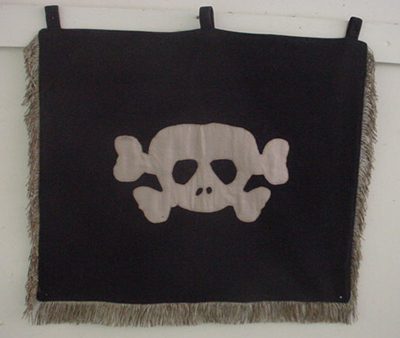 |
SS Trumpet Banner for the Totenkopf Verbande (Item FLAG 3-10, SS 35-24) |
DESCRIPTION: This is a very early trumpet banner of the Death's Head Standard. It is measured at 23 x 18 ½ inches not counting the fringe on the three sides; this silver bullion fringe is about 2 inches long. Also there are three cloth loops at the top that are about 1 ¼ inches long. These are for fastening the banner to the trumpet. The item has been black lighted and passes the tests. The piece was from the estate of PFC James D. Lund, U.S. Army 2679032 who was attached to the U.S. lst Armored Division. To see more about the Totenkopf Verbande go to our site in the Allgemeine SS section listings and go to page four and to SS 4-5. The skull on this banner is probably the ugliest I have ever seen but it must be kept in mind that in the earliest days of the NSDAP there was no issue of such things and it was pretty much go it on your own as far as such individual trappings were constructed. Much of the items like the banner would be pretty much left to the imagination of men in the units and perhaps their wives who did the sewing. The banner is certainly in keeping with the Esprit d’Corp of this unit of steel hard troopers. Later trumpet banners after 1934 were rather more artistically manufactured in a more professional manner. This however is much more rare in that it is a Kampzeit item (Time of Struggle). If it isn’t pretty it is strongly suggestive of power (Starke Macht!) These troops were not anyone that the Commie street hoodlums wanted to tangle with. They were tough and unrelenting. The material is a heavy grade wool that has a natural stiffness to it, not at all light or flimsy. The wool has the same weave pattern as some of the NSDAP banners. The skull being jawless is much like the Hussar skulls on the busbies of those stalwart elite horsemen of old. The SS runes and skull are fashioned from a high grade linen and are applied by way of heavy machine stitching in an overlapped (V) pattern. Both display dye bleed into them from the black wool base. They have brown age discoloring in areas. There is one area where the weave has been slightly broken on one rune where this was folded onto itself. The bullion has a cotton base that has age where it is exposed to a camel brown color and the bullion itself has an age patina that is exactly like other flags that we have acquired from veterans. So, we are quite content that this banner is 100% original and extremely rare. PRICE: SOLD |
 |
 |
SA Standarte Flag from Munchberg-Naila (Item FLAG 3-11 & SA 14-11) |
DESCRIPTION: This is an SA flag of honor from the Standarte Munchberg-Naila. This town is located near the border of Czechoslovakia. Naila is a small sub- community near Munchberg and is actually a suburb. The entire area is considered the ‘Hof.” The town of Helmbrechts is also in between and also is a suburb of Munchberg. Munchberg is considered the textile town of Bavaria. The first settlements of those towns date back to the 10th century. The first settlers were Monks and the original name of Munchberg probably was Monk Mountain. The first mention of the town as Munchberg was around 1223. In the time of the NSDAP 1920’s to late 1940’s, Munchberg was a true Bewegung center. Just like in most of Bavaria the people were fiercely loyal to Hitler and the N.S. Party. The first Chapter of the N.S. Party in this part of Bavaria was formed there in 1923. Otto Button was the Ortsgruppenleiter who introduced pro-N.S. films to the local populace like “Bleeding Germany” and the “New Italy” to boost morale and patriotism amongst the populace. The local textile industry in the 1930’s was practically defunct but with Hitler’s rise to power in 1933, business was booming again and soon made great record profits. Part of their success was in producing uniforms, tapestries, armbands and flags such as this one. However, this one is the flag of Munchberg-Nalia. Probably the only one that would represent the district. The ‘Braustubel”, the local tavern and the city and its suburbs were bedecked with Nazi flags every day of the week but one flag, the most honored of all, was shown in a showcase in the city hall and that is this one, the Honor Standard of the District of Upper Franken. Julius Streicher was the Gauleiter of this area and he also spoke in the Munchberg “Braustubel” and of course the standard would have been taken from its repository in the City Hall and it would be displayed on its flagpole held by an SA Fanentrager who would stand by the side of the speaker or behind holding the proud Munchberg-Naila standard. It would be carried in celebrations such as Hitler’s birthday April 20th, and on the 30th January the celebration of the Machtergreifung (the ascension to power of Hitler and the NSDAP). The standarte in full measures 54 x 45 inches not counting the 1 ½ inch silver fringe. The unit patch in the left corner is measured at 8 x 6 inches. It has 3 of the original flag pole rings still mounted on it. The veteran who it was purchased from provided two more rings that came unattached. They will go with the flag. The flag has some moth damage although there are quite a few bites taken by the destructive little buggers. The flag is still nice as you can see in the pictures and the moth munching does not detract from it all that much really. You have to get up close to see it at all but we have shot a few close ups in pictures of most of the mothing. The standarte is rare. It is double sided with center field Swastika and district patch on the obverse and reverse. This is an important piece of N.S. history and an absolutely great collector’s relic. PRICE: SOLD |
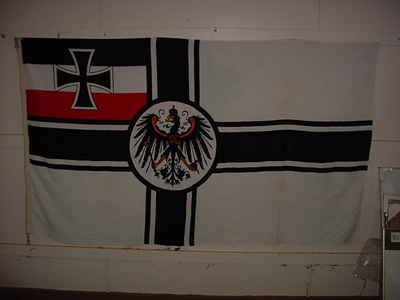 |
ReichsKreigsfahne ( Imperial War Flag) (Item FLAG 3-12 & FREI 1-12) |
DESCRIPTION: This is the flag that fluttered over many a battlefield of WW1. It was the war flag that was flown by both the German Army and Navy although it was seen on ships of the Kaisereich fleet mostly. It is a beautiful ensign with its Iron Cross and the Imperial Hohenzollern eagle that signifies the armed forces of the German Kaiser. The example we offer here is stone mint. We believe it is an example made in the late 20’s or 30’s and used by the Freikorps or the Kreigerbund or Kyfhauser bund (Veterans Organizaitons). It possibly hung in a meeting hall or was used in the parades of these groups. The quality is very good but it does not have the rope running through the bunting edge that would be used in a fold that would attach to a flagpole. We don’t think it was meant to fly. It is large (80 x 47) and it is marked on the edge bunting with the German size 200 x 120. A very dramatic looking banner and it was meant to be. Here is a chance to obtain this beautiful Kreigsfahne and pay much less than an actual flag that would look like this would cost. PRICE: SOLD |
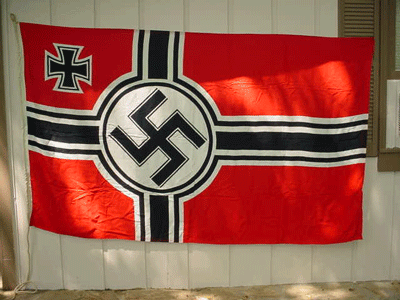 |
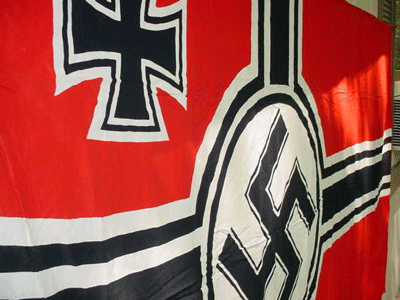 |
| Mint Condition Reichskreigsflage (Battle Flag) (Item FLAG 3-13) |
DESCRIPTION:Here is the finest naval war flag I have ever seen in many years. And it’s comparatively inexpensive when compared to the run of the mill ones that you see on other sites. It is a very desirable size 8 foot x 4 foot (96 x 56) to be exact -- it is marked along the bunting edge with size in German and the company of manufacture in Berlin as well as Reichskreigsflage spelled out and most importantly the N.S. Eagle with Swastika superimposed over the M for Marine (Navy). The full lanyard ropes are there also in clean mint condition. One could look far and wide for something comparable and never find one. While the average flags in this size are occasionally found out there, they usually have stains, moth holes, tears, etc. This one is free of all damage. A first class specimen of a flag that is disappearing in any condition and here we offer the best ever! One that you will be very proud to own if you are one of those discriminating collectors that have long sought a perfect Kreigsflage. PRICE: SOLD |
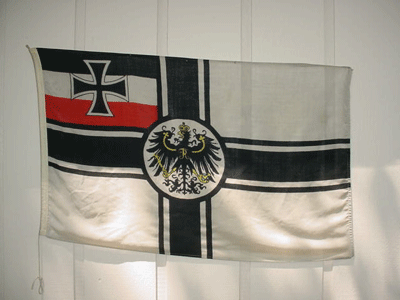 |
| Imperial Battle Flag (Item FLAG 3-14 & KCLOTH 2-8) |
DESCRIPTION: This is an original period German Reichskriegsfahne (military flag). This one is the ideal size for collectors – 3 ft. 10 inches long by 2 ft. 3 inches wide made with the regulation linen material. It is in great shape throughout and has the sail cloth bunting edge with lanyard rope for fastening to the pole. This was the size used on submarines and also landing craft that carried marine infantry units. Just a great little flag! PRICE: SOLD |